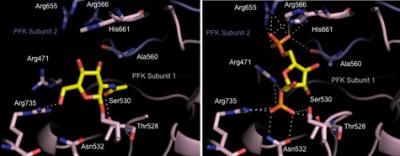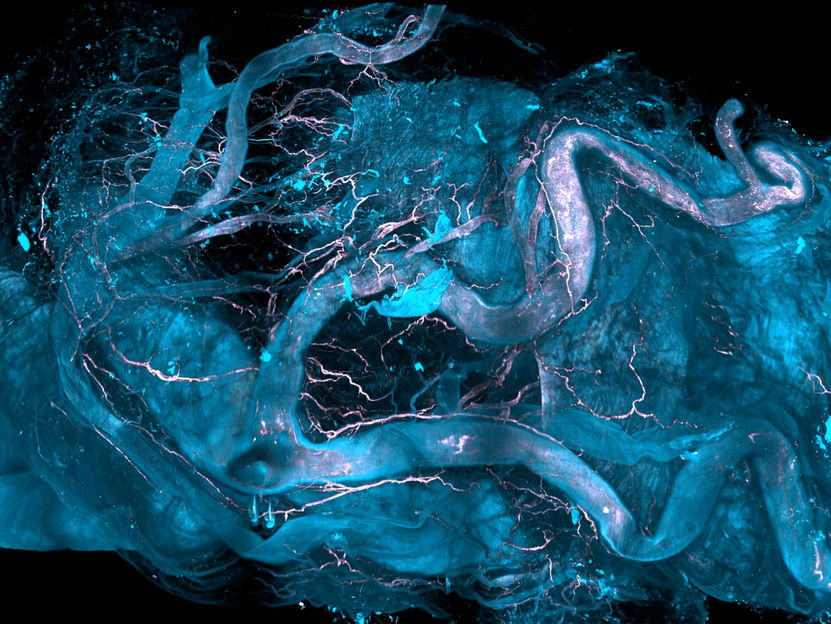MIT researchers discover an unexpected twist in cancer metabolism
Cancer-cell quirk could be exploited to develop new drugs that starve tumors
In a paper in Science, Matthew Vander Heiden assistant professor of biology and member of the David H. Koch Institute for Integrative Cancer Research at MIT and researchers at Harvard University report a previously unknown element of cancer cells' peculiar metabolism. They found that cells can trigger an alternative biochemical pathway that speeds up their metabolism and diverts the byproducts to construct new cells.
The finding could help scientists design drugs that block cancer-cell metabolism, essentially starving them of the materials they need to grow and spread. Vander Heiden has just begun tests in mice of several such drugs.
Just as trees can be turned into logs to build a new house, or firewood to generate heat, sugar can serve many purposes. In a normal cell, most of the sugar is burned up for energy, with little left over to build anything new. Cancer cells, on the other hand, need building blocks for new cells as well as energy.
"If you have a forest of trees, you can take all the trees and burn them and release a lot of energy, but you haven't built anything," says Vander Heiden. "To build a house out of it, you need to save some logs to turn them into lumber."
Most human cells burn a six-carbon sugar called glucose. Through a long chain of reactions that require oxygen, the cells extract energy from the sugar and store it in molecular energy packets known as ATP. Cells use ATP to power a variety of functions, such as transporting molecules in and out of the cell, contracting muscle fibers and maintaining cell structure.
Glucose metabolism normally occurs in two stages, the first of which is known as glycolysis. It has been known for decades that cancer cells perform gylcolysis only, skipping the second stage, which is where most of the ATP is generated.
Vander Heiden's new study focuses on glycolysis, traditionally thought to be a linear, nine-step process by which a cell turns one molecule of glucose into two molecules of pyruvate, an organic compound with three carbon atoms. That pyruvate is usually fed into the second phase of glucose metabolism.
"Everyone takes it for granted that this is how it works," says Vander Heiden, who did this research as a postdoctoral fellow in the lab of Harvard Medical School Professor Lewis Cantley, senior author of the paper. But the new study shows that "there is another way it can work, and this other way seems to be at play in proliferating cells." That could include rapidly dividing embryonic cells as well as cancer cells.
Scientists already knew that cancer cells replace one type of a key metabolic enzyme known as pyruvate kinase with another. Both versions of the enzyme (PKM1 and PKM2) catalyze the very last step of glycolysis, which is the transformation of a compound called PEP to the final product, pyruvate.
In the new study, the researchers found that PEP is involved in a previously unknown feedback loop that bypasses the final step of glycolysis. In cancer cells, PKM2 is not very active, causing PEP to accumulate. That excess PEP activates an enzyme called PGAM, which catalyzes an earlier step in glycolysis. When PGAM receives that extra boost, it produces even more PEP, creating a positive feedback loop in which the more PEP a cell has, the more it makes.
The most important result of this loop is that the cell generates a large pool of another chemical that is formed during an intermediate step of the reaction chain. Vander Heiden believes this compound, called 3-phosphoglycerate, is diverted into synthetic pathways such as the production of DNA, which can become part of a new cancer cell. In future studies, he plans to investigate how that diversion occurs.
This study suggests that drugs that activate PKM2 could be promising cancer treatments, says Vander Heiden. If PKM2 were highly activated, cancer cells would alter the metabolism of PEP, blocking the alternative pathway and hindering the production of new building blocks.
Original publication: Matthew G. Vander Heiden, Jason W. Locasale D. Swanson, Hadar Sharfi, Greg J. Heffron, Daniel Amador-Noguez, Heather R. Christofk, Gerhard Wagner, Joshua D. Rabinowitz, John M. Asara, and Lewis C. Cantley; "Evidence for An alternative glycolytic Pathway in rapidly proliferating cells."; Science 2010.

























































